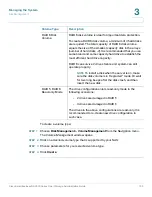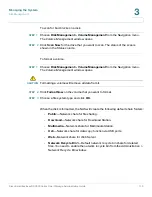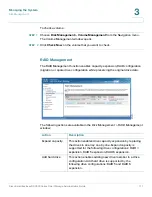
Managing the System
Disk Management
Cisco Small Business NSS300 Series Smart Storage Administration Guide
121
3
iSCSI Target Profile:
•
Target Name
—Enter the target name for the iSCSI storage resource.
•
Target Alias
—Enter the target alias for the iSCSI storage resource.
CRC/Checksum (Optional):
•
Data Digest
—Click to use the data digest procedure when identifying and
verifying the checksum.
•
Header Digest
—Click to use the header digest procedure when identifying
and verifying the checksum.
STEP 10
Click
Next
to continue to the authentication settings.
STEP 11
From the
CHAP Authentication Settings
window, enter the following parameters:
•
Use CHAP authentication
—Select to enable CHAP authentication. Using
CHAP authentication, only the iSCSI target authenticates the initiator. For
example, the initiators have to enter the user name and password setting
here to access the target.
•
User Name
—Enter the user name for CHAP authentication. Maximum
length is 256 characters.
•
Password
—Enter the password. Maximum length is 12-16 characters.
•
Re-enter Password
—Re-enter the password for verification.
•
Mutual CHAP
—Click to use the CHAP two-way authentication protocol
between the iSCSI target and initiator. The target authenticates the initiator
using the first set of username and password. The initiator authenticates the
target using the mutual CHAP settings.
•
User Name
—Enter the initiator user name for the mutual CHAP
authentication. Maximum length is 12-16 characters.
•
Password
—Enter the password. Maximum length is 12-16 characters.
•
Re-enter Password
—Re-enter the password for verification.
STEP 12
Click
Next
to create an iSCSI LUN. An iSCSI LUN is a logical volume mapped to the
iSCSI target.
STEP 13
From the
Create an iSCSI LUN
window, configure the following parameters:
•
LUN Allocation
—Select one of the following modes to allocate the disk
space to the LUN.
















































